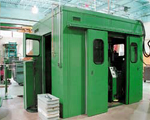“Wow, you guys are expensive”. I’ve heard this once or twice so far in my career. Interestingly, I hear it the most from industrial and manufacturing clients where employee noise exposure is a major issue in their operations. It’s true, the consulting fee can be a little overwhelming at first, however, if you step back and look at the larger picture, you might be surprised how inexpensive the fee can be.
Let’s start with what we do. Typically, one of our consultants will be on site for several days to view and monitor the operations. We listen and measure everything from the building systems noise and vibration to the actual manufacturing process equipment. Much like a professional photographer who is keyed into lighting conditions, we are keyed into the acoustical environment. I like to use the example that once we are on site; we see with our ears. So, what kinds of solutions can we offer that cannot be matched by a simple 35 cent pack of earplugs?
We typically use what we refer to as the triple “E” approach; we analyze the Environment, Equipment, and Employees.
- Environment
- We can “see” (hear) things that most people overlook. For example, we recently observed a facility where a higher humidity level was required for their manufacturing process. This meant mist sprayers were installed in the ceiling truss work. Upon entering the facility, you could plainly hear them, and we asked about them immediately. We found out that they had never really been calibrated and the system was operating under pressures that were not needed. Once the pressure was reduced, the system operated at a much more tolerable noise level and reduced the operating cost as a reduction in water and pump capacity was instantly realized.
- Equipment
- We know and understand that the equipment used in the manufacturing processes is one of the largest capital costs your company faces, however, we need to keep in mind that this equipment was designed to convert raw material to finished goods in as little time as possible. Often, custom fabricated machinery is designed and implemented with very little acoustical controls or measures. In another recent example, we toured a facility and air-knives were an integral part of their process. Analysis also showed that they were a major contributing factor to the employee’s noise exposure. Some simple investigation revealed a variety of nozzle types, varying numbers of nozzles, and different air pressures all existed for the exact same process across several lines. By simplifying the design and keeping one type of nozzle and layout we were able to reduce the noise levels and as a result simplified the maintenance of this system.
- Employees
- Surprisingly, considering the employees as part of the solution to noise mitigation and reduction is often forgotten. Simple administrative policy changes such as rotating employees through noisy areas rather than spending an entire shift in that area, changes in the handling of materials, and increasing awareness for noise generating activities are all solutions that we have seen implemented and created a much safer and quieter environment.
So, what is the payoff? The two major things that we see happening as a result of a well-executed noise reduction program are: reduced noise levels below OSHA action levels resulting in a cost savings for the company (minimizing the effort needed for a hearing conservation program and creating savings in ongoing monitoring, testing, protection, and treatment) and a much healthier work environment for your employees. The reality is any relief from high noise levels creates a much better work environment and will positively impact employee productivity.
